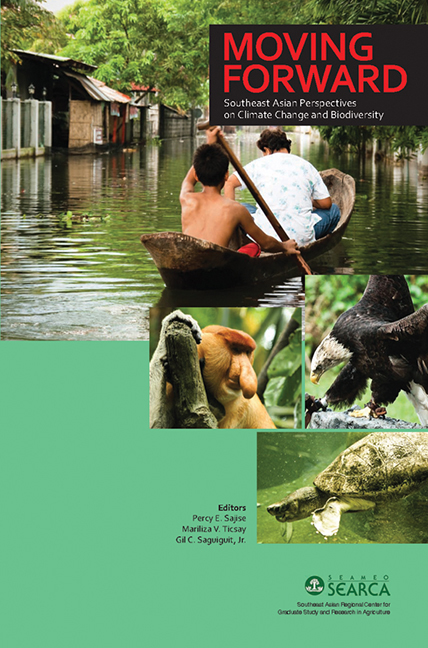Preface
Published online by Cambridge University Press: 21 October 2015
Summary
Climate change is a global phenomenon that is manifested by significant changes in weather parameters. These changes are mainly due to human activities which significantly increased greenhouse gases (GHGs) in the atmosphere over many years.
Past and current trends of weather parameters were measured using 21 global climate models. These models were based on atmospheric science, chemistry, physics, biology, and at times astrology. They were run using past and present scenarios of GHG emissions.
Climate change is inevitable. It will continue to happen even if current emissions of GHGs are stopped. Some areas will become hotter and drier, while other areas will have more rains than usual. There are still changes happening in other places, even in Southeast Asia, but most of these are not documented properly.
Some of the predicted changes or manifestations of climate change are increased water availability in most tropics and high latitude areas, and decreased water availability and drought in mid- and low-latitude areas. Global temperatures are likely to increase by 1.1-6.4 °C from 1990 to 2100, with best estimates of 1.8-5.4 °C. Sea level is expected to rise by 22-34 cm between 1990 and 2080. The most revealing demonstration of this effect is in the island atolls of the Pacific. Extreme events will likely manifest such as tropical cyclones, typhoons, and hurricanes, with larger peak wind speeds and heavier precipitation.
THE CONCERN FOR CLIMATE CHANGE
Climate change is considered a major constraint in the attainment of the Millennium Development Goals (MDGs) especially if the global community is not prepared for it. Climate change will increase the existing risks and vulnerability of people and ecosystems. The most vulnerable sector will be the least developed countries in the tropics and sub-tropics, especially the impoverished communities.
The 2007 report of the Intergovernmental Panel on Climate Change (IPCC) indicated evidences that show the decline of mountain glaciers and snow cover in both hemispheres. This decline is contributing to the rise in sea levels, especially in the Pacific island atolls and other coastal areas of small islands.
- Type
- Chapter
- Information
- Moving ForwardSoutheast Asian Perspectives on Climate Change and Biodiversity, pp. xix - xxivPublisher: ISEAS–Yusof Ishak InstitutePrint publication year: 2010



